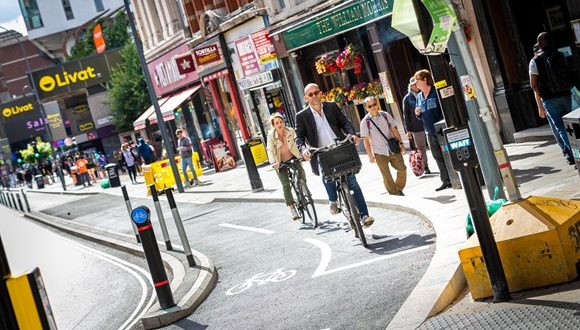TfL has completed work to transform the roads around Hammersmith gyratory, set to make walking and cycling safer and easier with new protected cycle lanes and new pedestrian crossings.
The changes will help to build on the huge increases in cycling seen in the capital since the start of the coronavirus pandemic and will it easier and safer to walk and cycle in the area.
The new cycleway will open up safe and attractive cycling across west London to Gunnersbury, Chiswick, East Acton, North Acton and Ravenscourt Park, said TfL.
The changes were developed in partnership with Hammersmith and Fulham Council and include:
– A protected two-way cycle track on the north side of Hammersmith gyratory
– Cyclist-specific signals at junctions to separate cyclists and motor vehicles
– Improvements for pedestrian safety at all junctions with side roads, including raised level crossings and more footway space
– New pedestrian crossing signals with ‘countdowns’ at the crossings of King Street, Beadon Road, Shepherd’s Bush Road, Queen Caroline Street, Hammersmith Road and Butterwick
– A new parallel crossing at the Butterwick junction to allow westbound cyclists to join the two-way cycle track
There were 30 collisions on the Hammersmith gyratory in the three-year period to December 2020, of which five involved someone cycling. Before work started on the gyratory, recent cycle counts from 12th October 2021 also counted 2,844 people cycling between 7am and 7pm.
TfL has also completed work on a further section of Cycleway 4. Once complete, the route will connect neighbourhoods in southeast London to central London via a fully protected cycle route between Tower Bridge Road and Greenwich. The latest completed section on Creek Road in Deptford includes a two-way protected cycle track between on Creek Road between Deptford Church Street and Norman Road, adding 1.6km of London’s network of protected cycle routes. A new pedestrian crossing has also been built on the western arm of the Deptford Church Street junction.
Will Norman, the Mayor’s walking and cycling commissioner, said: “I’m delighted that work on the new and transformed Hammersmith gyratory has been completed. This delivers much-needed protected cycle lanes and pedestrian crossings – making walking and cycling safer and easier at this busy junction. It’s also great news that the new section of Cycleway 4 is now open in Deptford – as we continue to roll out our cycle network across London.
“Enabling more Londoners to walk and cycle continues to be at the heart of the Mayor’s vision to build a safer, healthier, cleaner and more sustainable London for everyone. These crucial improvements across the city will help us to continue to build upon the boom in cycling we’ve recently seen, helping all cyclists keep safe on the roads.”
Read more: Specialized releases three new helmets – Evade, Prevails and new S-Works TT
TfL has also published casualty statistics that show the number of people tragically killed on London’s roads in 2021 fell by 22% to the lowest level on record, compared to a 7% increase nationally. Despite this decrease, overall casualties have increased since the coronavirus lockdowns ended and traffic has returned.
Whilst travel habits continued to change in 2021, the lifting of most pandemic restrictions in July 2021 saw a gradual return to normal activity. As traffic returned to pre-pandemic levels, the number of people who were killed or seriously injured increased by 17%, rising from 3,070 in 2020 to 3,580 in 2021.
Vulnerable road users continue to be most at risk with people walking, cycling and motorcycling making up 81% of all people killed or seriously injured in 2021. The number of people killed while cycling in 2021 was down by 40% on the 2005-09 baseline, from 17 to 10 people.
However, serious injuries to people cycling increased by 54%. This partly reflects increases in the number of journeys cycled, with the most recent figures showing the share of road journeys by bicycle almost doubling to 4%.
Since the start of the pandemic, TfL has worked closely with boroughs across the capital to invest in the walking and cycling infrastructure needed to enable increases in active travel and keep people walking and cycling safe. This includes more than 100km of new or upgraded cycle lanes, 89 Low Traffic Neighbourhoods, and 322 ‘School Streets’. By autumn 2021, 19.4% of Londoners lived within 400 metres of a cycle route, an increase of approximately 750,000 residents since 2019.
Mayor of London Sadiq Khan said: “Every death and serious injury on our roads is a tragedy and I refuse to believe that they are something we have to accept as inevitable. Our Vision Zero action plan sets out tough measures to help reduce risk and eliminate death and serious injury from London’s roads.
“The pandemic has also demonstrated that fewer cars on our roads mean fewer deaths and serious injuries, which is why I’m determined to make sure we deliver a green recovery in London by encouraging more Londoners to walk and cycle.
“The cost to the capital of a car-led recovery cannot be underestimated, with increased road danger, detrimental health impacts, time wasted stuck in traffic and billions lost to the economy. There is still much more to do to eradicate road deaths and serious injuries from our streets, but I am determined that together we will help make London greener, more sustainable and safer all.”
 BikeBiz Bicycle and cycling retail news
BikeBiz Bicycle and cycling retail news




